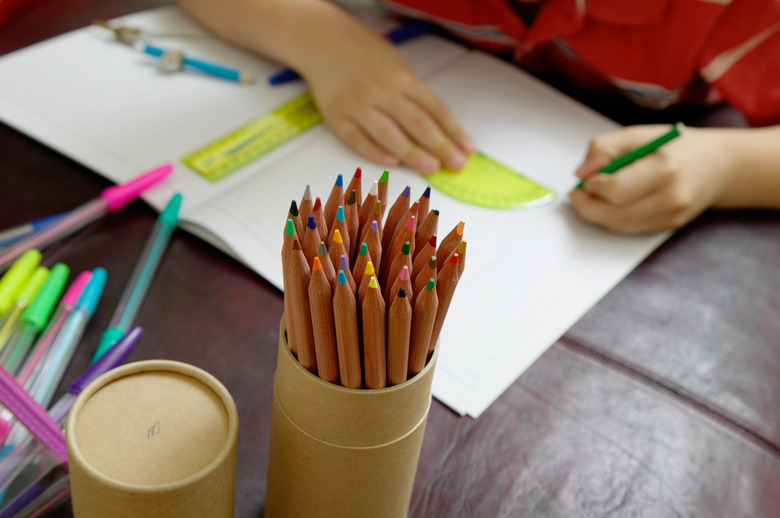Cross Curricular Geometry Activities For Plane & Solid Shapes
Plane and solid shape geometry is a course of study that easily lends itself to cross-curricular activity. While plane geometry is about flat shapes, and solid shape geometry is about three dimensional ones, the two fields share an interest in common shapes like triangles, squares and circles. Numerous fields, incuding literature, art and science, can provide cross-curricular insights on plane and solid geometry.
Art Lessons
Art Lessons
One of the easiest cross-curricular activities for the study of plane and solid geometry can come in the form of an art class. Numerous famous artists — from Picasso to Kandinsky to Rothko — used geometric shapes, either partially or exclusively, in their art. Students might examine the history of art and write an essay about a specific artist and his or her use of geometry in an artistic sense. Alternatively, students might be encouraged to create geometric art of their own. For plane geometry, students could mirror Rothko and Picasso by using geometry in drawing. For solid geometry, students could make sculptures or even origami.
Chemistry Insights
Chemistry Insights
Among the sciences, chemistry provides one of the best opportunities to see how geometry is used actively in the natural world. All chemical molecules make use of geometric shapes to form their connections. This is called molecular geometry. Students can examine a wide variety of compounds and, using their previous knowledge of chemical principles, determine what molecular shape the compound will form. This will take students through shapes that include everything from simple ones — like triangles — to complex shapes like tetrahedral and bypyramidal shapes. Students might even be encouraged to build their own models with art supplies like sticks and glue.
Vocabulary Activities
Vocabulary Activities
While math might not immediately seem to have a strong relationship to English, plane and solid geometry provides a very important vocabulary lesson. Many shape names — from triangle to quadrilateral to pentagon — provide root words that can be applied to other words. Students can learn complex words like "trifurcated," which has the same root word "tri," meaning three. Other words — like the "lateral" in quadrilateral — provide other applicable vocabulary. For an activity, students might first learn about these roots words and then, with no previous knowledge, be asked to guess the definitions of words like "bilateral" and "periscope."
Mapping History
Mapping History
Understanding of history, especially military history, can be enhanced by a knowledge of geometry. Many of history's greatest military feats, from Ancient Rome to the American Revolution to World War II, relied on shapes, angles and measures to find success. One interesting and fun activity might be to find an historical text where a military general describes the movement of his troops in a specific region. If necessary, this text could be "translated" to include more specific geometry terms, like angles and shapes. With this knowledge and a map, students could then draw the movements of a general and his troops. In the process, they will learn how to practically apply geometry, how to read maps, and how history has unfolded.
Cite This Article
MLA
Wandrei, Kevin. "Cross Curricular Geometry Activities For Plane & Solid Shapes" sciencing.com, https://www.sciencing.com/cross-curricular-geometry-activities-for-plane-solid-shapes-12759525/. 3 January 2014.
APA
Wandrei, Kevin. (2014, January 3). Cross Curricular Geometry Activities For Plane & Solid Shapes. sciencing.com. Retrieved from https://www.sciencing.com/cross-curricular-geometry-activities-for-plane-solid-shapes-12759525/
Chicago
Wandrei, Kevin. Cross Curricular Geometry Activities For Plane & Solid Shapes last modified August 30, 2022. https://www.sciencing.com/cross-curricular-geometry-activities-for-plane-solid-shapes-12759525/
